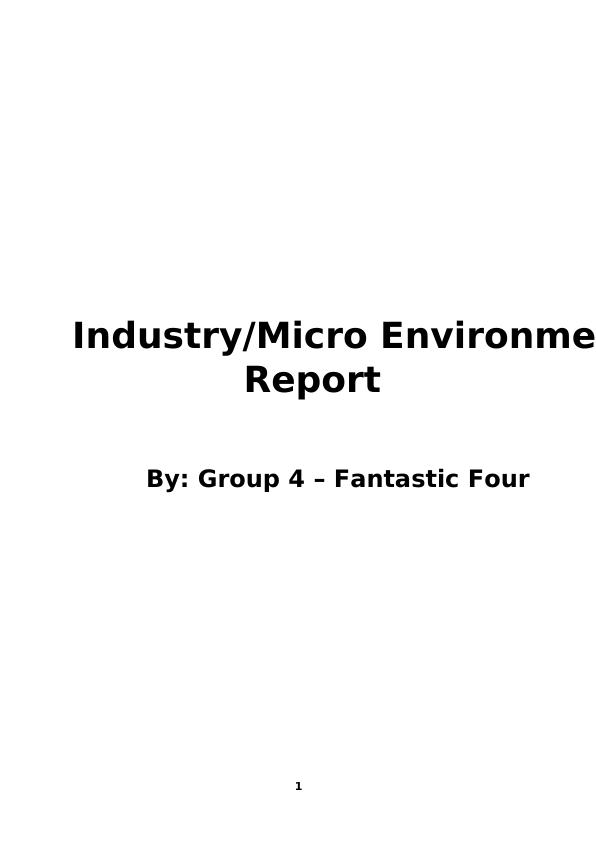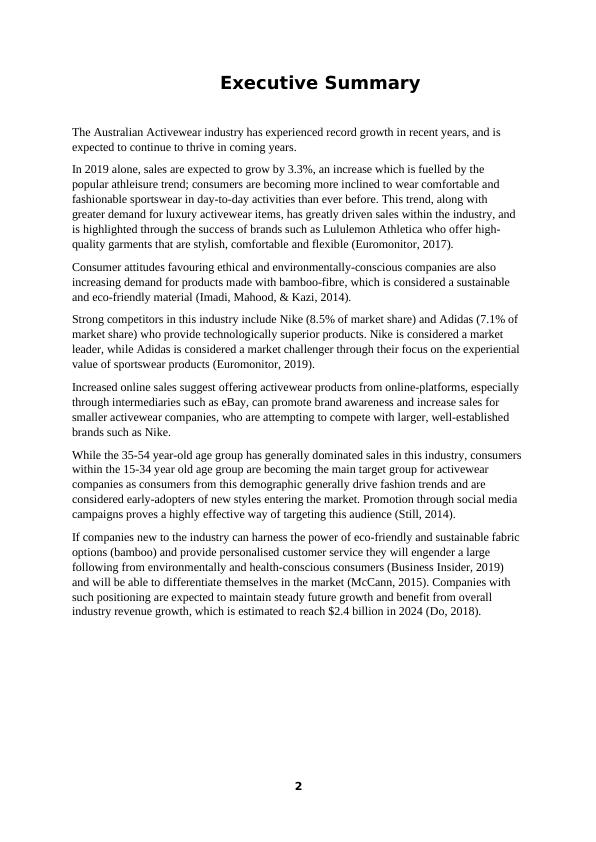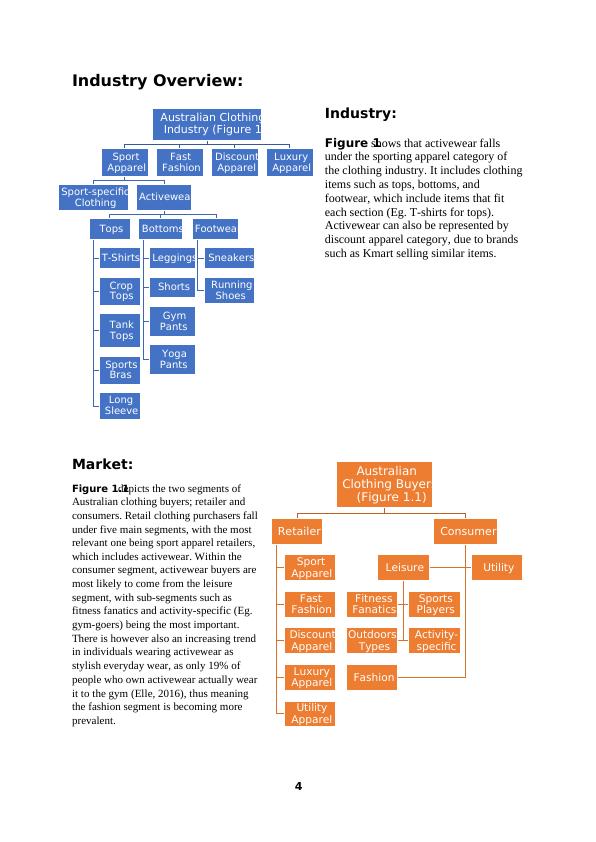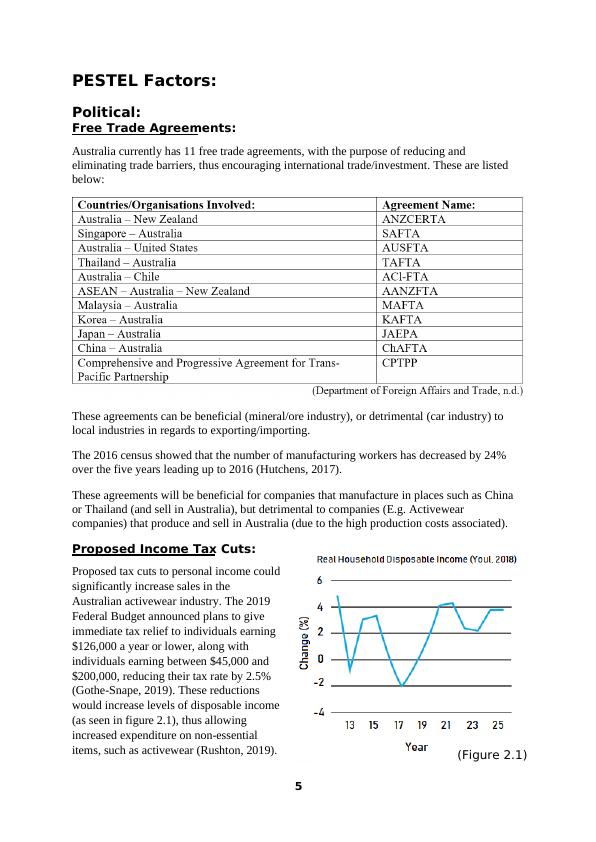Micro Environment - Assignment
Added on 2021-01-19
28 Pages7443 Words159 Views
1 Industry/Micro Environment Report By: Group 4 – Fantastic Four

2 Executive Summary The Australian Activewear industry has experienced record growth in recent years, and is expected to continue to thrive in coming years. In 2019 alone, sales are expected to grow by 3.3%, an increase which is fuelled by the popular athleisure trend; consumers are becoming more inclined to wear comfortable and fashionable sportswear in day-to-day activities than ever before. This trend, along with greater demand for luxury activewear items, has greatly driven sales within the industry, and is highlighted through the success of brands such as Lululemon Athletica who offer high-quality garments that are stylish, comfortable and flexible (Euromonitor, 2017). Consumer attitudes favouring ethical and environmentally-conscious companies are also increasing demand for products made with bamboo-fibre, which is considered a sustainable and eco-friendly material (Imadi, Mahood, & Kazi, 2014). Strong competitors in this industry include Nike (8.5% of market share) and Adidas (7.1% of market share) who provide technologically superior products. Nike is considered a market leader, while Adidas is considered a market challenger through their focus on the experiential value of sportswear products (Euromonitor, 2019). Increased online sales suggest offering activewear products from online-platforms, especially through intermediaries such as eBay, can promote brand awareness and increase sales for smaller activewear companies, who are attempting to compete with larger, well-established brands such as Nike. While the 35-54 year-old age group has generally dominated sales in this industry, consumers within the 15-34 year old age group are becoming the main target group for activewear companies as consumers from this demographic generally drive fashion trends and are considered early-adopters of new styles entering the market. Promotion through social media campaigns proves a highly effective way of targeting this audience (Still, 2014). If companies new to the industry can harness the power of eco-friendly and sustainable fabric options (bamboo) and provide personalised customer service they will engender a large following from environmentally and health-conscious consumers (Business Insider, 2019) and will be able to differentiate themselves in the market (McCann, 2015). Companies with such positioning are expected to maintain steady future growth and benefit from overall industry revenue growth, which is estimated to reach $2.4 billion in 2024 (Do, 2018).

3 Contents Industry Overview: ............................................................................................................................. 4 PESTEL Factors: ................................................................................................................................ 5 Political: ....................................................................................................................................... 5 Economic: .................................................................................................................................... 6 Legal: ........................................................................................................................................... 7 Demographic: .............................................................................................................................. 8 Social: ......................................................................................................................................... 10 Environmental: ......................................................................................................................... 11 Technological: ........................................................................................................................... 12 Competitor Analysis: ........................................................................................................................ 13 Collaborator Analysis:...................................................................................................................... 17 Customer Analysis: ........................................................................................................................... 22 Key Success Factors: ........................................................................................................................ 24 Reference List: .................................................................................................................................. 25

4 Industry Overview: Industry: Figure 1shows that activewear falls under the sporting apparel category of the clothing industry. It includes clothing items such as tops, bottoms, and footwear, which include items that fit each section (Eg. T-shirts for tops). Activewear can also be represented by discount apparel category, due to brands such as Kmart selling similar items.Market: Figure 1.1depicts the two segments of Australian clothing buyers; retailer and consumers. Retail clothing purchasers fall under five main segments, with the most relevant one being sport apparel retailers, which includes activewear. Within the consumer segment, activewear buyers are most likely to come from the leisure segment, with sub-segments such as fitness fanatics and activity-specific (Eg. gym-goers) being the most important. There is however also an increasing trend in individuals wearing activewear as stylish everyday wear, as only 19% of people who own activewear actually wear it to the gym (Elle, 2016), thus meaning the fashion segment is becoming more prevalent. Australian Clothing Industry (Figure 1)Sport ApparelSport-specific ClothingActivewearTopsT-ShirtsCrop TopsTank TopsSports BrasLong SleeveBottomsLeggingsShortsGym PantsYoga PantsFootwearSneakersRunning ShoesFast FashionDiscount ApparelLuxury ApparelAustralian Clothing Buyers (Figure 1.1)RetailerSport ApparelFast FashionDiscount ApparelLuxury ApparelUtility ApparelConsumerLeisureFitness FanaticsSports PlayersOutdoorsy TypesActivity-specificUtilityFashion

5 PESTEL Factors: Political: Free Trade Agreements: Australia currently has 11 free trade agreements, with the purpose of reducing and eliminating trade barriers, thus encouraging international trade/investment. These are listed below: These agreements can be beneficial (mineral/ore industry), or detrimental (car industry) to local industries in regards to exporting/importing. The 2016 census showed that the number of manufacturing workers has decreased by 24% over the five years leading up to 2016 (Hutchens, 2017). These agreements will be beneficial for companies that manufacture in places such as China or Thailand (and sell in Australia), but detrimental to companies (E.g. Activewear companies) that produce and sell in Australia (due to the high production costs associated). Proposed Income Tax Cuts: Proposed tax cuts to personal income could significantly increase sales in the Australian activewear industry. The 2019 Federal Budget announced plans to give immediate tax relief to individuals earning $126,000 a year or lower, along with individuals earning between $45,000 and $200,000, reducing their tax rate by 2.5% (Gothe-Snape, 2019). These reductions would increase levels of disposable income (as seen in figure 2.1), thus allowing increased expenditure on non-essential items, such as activewear (Rushton, 2019).(Figure 2.1)

6 Economic:The Australian economy is expected to strengthen in coming years; according to the Australian Bureau of Statistics (ABS) wage price indexes rose 2.3% in 2018 and unemployment rates are expected to decrease (OECD, 2018). Customer sentiment index, concerning an individual's feelings towards the overall economy and their own financial position, is also forecasted to stay positive throughout 2019. The combination of these factors will propel personal wealth and discretionary income (as seen in figure 2.2) and encourage the procurement of activewear (Do, 2018). Australian GDP is forecasted to go up to 1,700.63 billion USD by 2022. Overall growth in the activewear industry and economy have been a major contributor to such GDP growth. Australian tourism has also increased, meaning increased sales traffic for activewear retailers. Tourists are likely to purchase higher-value activewear and non-essentials on their visits, leading to a massive forecasted rise in sales of sportswear in Australia. (Figure 2.2)

End of preview
Want to access all the pages? Upload your documents or become a member.
Related Documents
Adidas: Growth, Strategies, and Competitive Analysislg...
|15
|992
|23
Business Environment Assignment - Adidaslg...
|12
|3302
|157
Growing cost of raw materials and laborlg...
|16
|3882
|14
Marketing Plan for Nike: Opportunity Analysis, Market Analysis, Competitor Analysis, SWOT Analysislg...
|15
|2922
|382
Comparison of Nike and Adidas Strategies in the Material Industrylg...
|10
|2781
|321
Identify Marketing Strategylg...
|17
|5145
|72